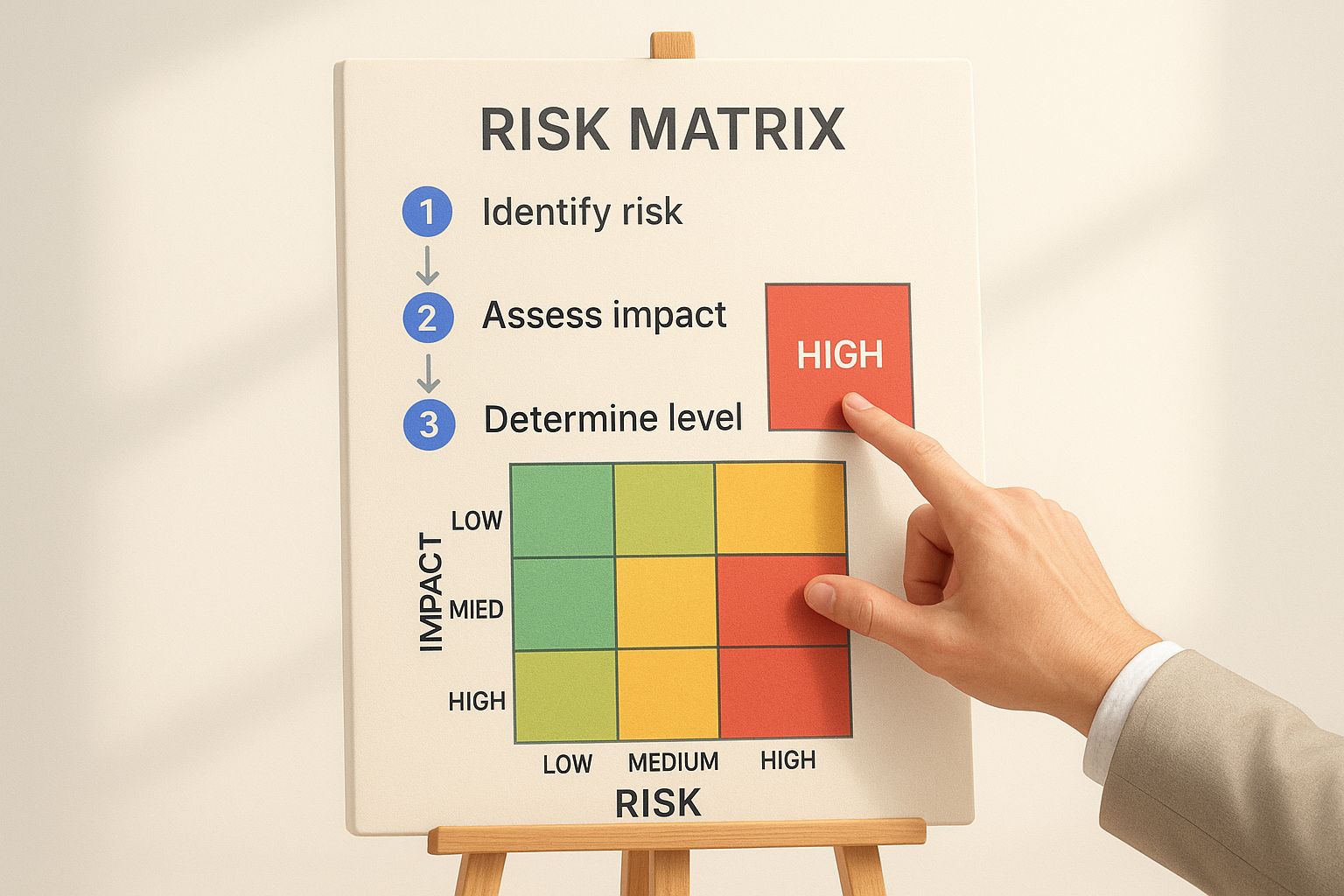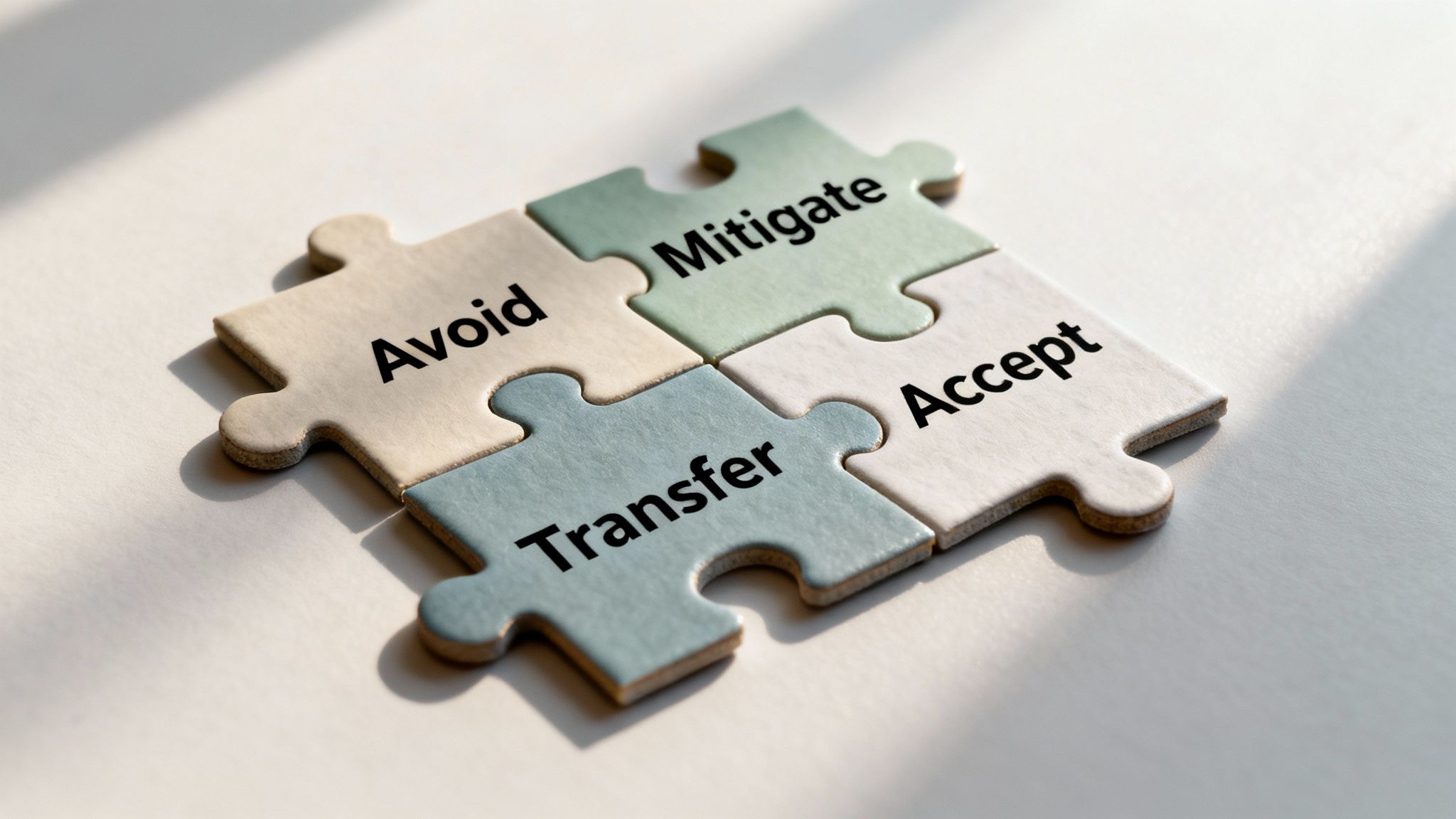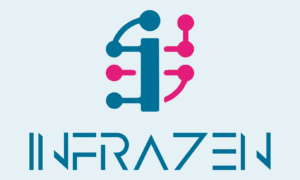The risk management cycle is a simple, repeatable five-step process that helps businesses spot, understand, and control threats. Think of it less as a one-off task and more as a continuous loop designed to make you more resilient and help you make better decisions over time. It’s the framework that turns those vague, late-night worries into a clear, manageable action plan.
Why Risk Management Is Your Agency's Creative Ally

For a lot of creative agencies, the phrase "risk management" conjures up images of soul-crushing spreadsheets and bureaucratic red tape- the very opposite of creativity. But that’s a huge misconception. In reality, a smart risk management process is a strategic framework that protects your creative work and gives your team the confidence to push boundaries.
It’s actually a lot like the creative process itself. You iterate on a design, you refine a campaign concept, and in the same way, the risk management cycle is an ongoing process of improvement. It’s all about being proactive instead of reactive, making sure a brilliant idea doesn’t fall apart the moment it hits a real-world snag.
The Core Purpose of the Risk Management Cycle
This guide breaks down each phase of the risk management cycle, with practical context for the fast-moving world of creative studios and agencies. Getting a handle on this process is the key to avoiding the common pitfalls that derail projects, blow budgets, and sour client relationships.
At its heart, the cycle is there to help you:
- Prevent project failures by catching things like scope creep or a sudden resource shortage long before they become emergencies.
- Manage client expectations with honest, clear communication about potential bumps in the road and how you plan to navigate them.
- Ensure financial stability by spotting potential budget overruns or surprise costs while there’s still time to do something about them.
A solid risk process doesn't just stop disasters; it builds the stable foundation your agency needs to confidently take on bigger, more ambitious projects. It’s the behind-the-scenes structure that allows creativity to thrive without the chaos.
Ultimately, mastering this cycle is fundamental to building a future-proof creative business in the digital age. It transforms uncertainty from a threat you fear into a strategic advantage you can use, allowing your agency to operate with far more clarity and purpose.
Identifying Your Agency's Hidden Risks
The first step in any solid risk management cycle is identification. This isn’t about making a generic list of things that could go wrong; it’s a proactive hunt for the specific, tangible threats that could derail your agency's projects, finances, or reputation before they spiral into full-blown crises.
For a creative agency, these risks often hide in plain sight. Think about the fallout from a key client leaving unexpectedly, a project's scope creeping endlessly outwards, or a simple data mistake that wipes out years of hard-earned client trust. Spotting these possibilities isn't pessimistic- it’s the foundation of resilience.
Practical Methods for Uncovering Risks
To move beyond vague worries, you need structured ways to pinpoint what could go wrong. A government, for example, uses massive frameworks to identify national threats. The UK's National Risk Register outlines 89 distinct risks, from infrastructure failures to pandemics, to prepare the country. While your agency’s scale is different, the principle of systematic identification is exactly the same. You can find more insights into how the UK organises its risk management strategies on thebci.org.
For your agency, this boils down to a few targeted activities:
- Focused Brainstorming: Get your team in a room- designers, project managers, and account leads- and ask a simple question: "What keeps you up at night about this project or client?" Their frontline perspective is pure gold.
- Agency-Specific SWOT Analysis: Go beyond a standard SWOT (Strengths, Weaknesses, Opportunities, Threats). Zero in on the 'Threats' quadrant and list specific project and operational dangers, like relying on a single piece of software or losing a specialist team member.
- Project Post-Mortems: Look back at past projects, especially the ones that went sideways. What went wrong? These "lessons learned" sessions are a goldmine for spotting recurring risks you can get ahead of next time.
The goal here is to build a comprehensive risk register– a living document that lists every potential threat. This simple act transforms abstract fears into a concrete inventory of issues you can start to actively manage.
Creating Your Initial Risk Register
Your risk register doesn't need to be some complex beast; a simple spreadsheet is the perfect place to start. What matters is capturing the right details. For each risk you've identified, note what it is, what might cause it, and which parts of the business it could impact.
For example, a digital risk could be a data breach. Documenting this means more than just writing "cybersecurity." It means identifying specific weak spots. To get a feel for how these threats are broken down and categorised by professionals, it's worth exploring a cybersecurity risk assessment template.
By diligently cataloguing these potential issues, you create the essential groundwork for everything that follows. This first step provides the clarity you need to analyse and prioritise which dangers truly demand your attention.
Analysing and Evaluating Project Dangers
So, you’ve identified a long list of potential threats. What now? This next phase in the risk management cycle can feel a bit overwhelming. You’re staring at a catalogue of everything that could go wrong, but not all risks are created equal. The real skill is separating the genuine dangers from the minor headaches, and that’s where analysis and evaluation come in.
This stage is really two steps rolled into one practical workflow. First, you analyse the nature of each risk, and then you evaluate where it belongs on your priority list. Don't worry, this isn't about firing up a spreadsheet full of complex formulas. It’s about asking two straightforward questions for every risk you’ve jotted down:
- How likely is this to actually happen? Are we talking near-certainty, a coin toss, or a complete long shot?
- If it does happen, how bad would it be? Would it be a project-killing catastrophe, a significant setback that costs time and money, or just a minor inconvenience?
Using a Risk Matrix to Prioritise
To get a clear, visual handle on this, you can plot each risk on a simple matrix. This tool is brilliant for categorising risks into low, medium, and high-priority zones based on their likelihood and potential impact.
For a creative agency, the difference becomes obvious with a couple of examples. A junior designer using a slightly off-brand font on an internal presentation has a low impact, even if the likelihood feels medium. Annoying, but not a disaster. On the other hand, your new project management software crashing a week before a major client deadline has a high impact, even if the likelihood seems low. The first is a blip; the second is a potential catastrophe.
The infographic below shows how a risk matrix helps you focus your attention on the real threats- the ones in that high-impact, high-likelihood quadrant.

This kind of visualisation makes it instantly clear that any risks landing in that top-right corner demand your immediate attention and resources.
Risk Evaluation Matrix for Creative Agencies
To make this even more practical for agencies, here’s a simple table to help you plot where your specific risks fall. Think of it as a cheat sheet for turning vague worries into a clear action plan.
| Impact Level | Low Likelihood | Medium Likelihood | High Likelihood |
|---|---|---|---|
| High | Prepare for it | Address Immediately | CRITICAL – Top Priority |
| Medium | Monitor it | Plan for it | Address Soon |
| Low | Acknowledge it | Keep an eye on it | Mitigate if easy |
By plotting each identified risk- from client feedback delays to software failures- into this matrix, you can quickly see which issues need a dedicated strategy and which can simply be monitored.
Turning Analysis into Actionable Insight
Once you've sorted your risks, your path forward becomes much clearer. The risks clustered in the "high" category are your immediate targets; you need to develop strategies for them right now. Those in the "medium" zone need a plan, but they aren’t quite as urgent. As for the "low" risks? They might just require you to keep an eye on them.
This structured approach stops you from feeling swamped. Instead of trying to fix everything at once, you can channel your energy and resources into neutralising the threats that genuinely jeopardise your projects and profitability.
This process is a cornerstone of effective agency operations. Good evaluation doesn’t just protect individual projects; it strengthens the health of your entire business. For more on this, check out our guide on project management for agencies. With your risks properly analysed and prioritised, you’re perfectly set up for the next step: deciding exactly what to do about them.
Choosing the Right Strategy to Treat Risks

You’ve done the hard work of identifying, analysing, and evaluating your agency’s risks. Now you’ve arrived at the most hands-on part of the whole process: deciding what to do about them. This is the treatment phase, where you choose a specific strategy for each high-priority threat you’ve unearthed. It’s about making a deliberate choice, not just crossing your fingers and hoping for the best.
Let’s be clear: there’s no single "correct" response for every risk. Instead, you have a toolkit of four primary strategies to pick from. The real skill is matching the right response to the nature and severity of the risk, making sure your actions are proportionate and actually work for your agency.
The Four Core Risk Treatment Strategies
Think of these four options as different paths you can take to handle a potential problem. Each serves a distinct purpose, and knowing which one to use when is what makes risk management effective. Your choice will always come down to a balance: the risk’s potential impact versus the cost and effort of getting it under control.
-
Avoid: This is the most direct approach- you simply eliminate the risk by not moving forward with the activity causing it. For an agency, that could mean turning down a project with a client notorious for late payments or refusing to build a campaign on unproven, glitchy technology.
-
Mitigate: Mitigation is all about reducing a risk’s likelihood or its potential impact. It’s the most common strategy you’ll use. This could involve creating a stricter client feedback and sign-off process to stop scope creep in its tracks, or cross-training team members so you’re not dangerously reliant on one person.
-
Transfer: This strategy is about shifting the financial fallout of a risk onto a third party. The classic example for any creative agency is professional indemnity insurance. It transfers the financial consequences of certain professional mistakes to an insurer, protecting your bottom line.
-
Accept: Let’s be realistic- sometimes, the cost of dealing with a risk is far greater than the damage it could possibly cause. Acceptance is a conscious decision to live with a risk, usually because it’s minor. You might accept the small risk of a typo in an internal memo because a multi-stage proofreading process just isn't worth the effort.
These strategies are flexible tools, not rigid rules. The art of the risk management cycle lies in applying the right treatment to the right problem, ensuring your response is both strategic and practical.
Applying the Strategies in a Modern Context
Your approach to treating risks can’t exist in a vacuum; it has to consider the world your agency operates in. The UK's risk management field, for example, is increasingly shaped by compliance trends around AI policies and new cybersecurity laws. Strategic insights show a growing focus on AI governance and much stronger cyber defences to handle new technological threats.
When it comes to digital threats, for instance, an agency might mitigate risk by rolling out new security protocols. This could even involve looking into managed cyber security services to transfer the heavy lifting of complex security monitoring to experts. Some agencies are even going beyond traditional insurance and exploring advanced risk financing, like forming a Captive Insurance Company to manage specific, unique risks themselves.
By choosing the right response, you transform your risk register from a list of worries into a proactive plan for protecting your agency's future.
Keeping Your Risk Management Plan Relevant
A risk management plan isn't something you create once and then shove in a drawer. If you do that, you're essentially designing a brilliant new website and then never updating it. It looks great for a while, but over time, it becomes outdated, ineffective, and totally irrelevant as new challenges pop up.
The risk management cycle doesn’t really have a finish line- it’s a continuous loop. This final phase, monitoring and review, is what turns your plan from a static document into a living, breathing tool that actually protects your agency. It's how you check your strategies are working and spot new threats coming over the horizon.
For a creative agency, the ground can shift incredibly fast. A key client might pivot their entire business, a new piece of tech could completely change your workflow, or a competitor could launch a service that eats into your market. Without keeping an eye on things, you’ll be flying blind until it’s too late.
Weaving Monitoring into Your Agency’s Rhythm
The trick here is to build risk monitoring into the way you already work, not to treat it as some separate, painful chore. You don't need to start holding daily risk meetings. Instead, make it a natural part of your agency's operational rhythm.
Here are a few practical ways to do just that:
- Quarterly Management Meetings: Carve out a small part of your regular leadership meetings for a quick, high-level look at the agency’s risk register. Are the big risks still the big risks? Has anything new and nasty appeared on the radar?
- Project Kick-offs and Debriefs: Use your project milestones to your advantage. When you're kicking off a major project, review any relevant risks. After it's all wrapped up, use the post-mortem to ask, "What unexpected problems did we hit, and should we add them to the risk register for next time?"
- Annual Strategy Reviews: Once a year, it's time for a proper deep dive into your entire risk management plan. This is your chance to really challenge your assumptions and make sure your strategies are still the best ones for the job.
Tracking and Adapting to New Threats
Good monitoring isn't just about staring at your existing list; it's about actively scanning for what’s coming next. Financial stability, for example, is a huge one that needs constant attention. In the UK, the Bank of England’s Financial Stability Report is a great indicator of how crucial it is to monitor the economic weather.
Recent reports maintained a key capital buffer rate at 2%, which shows a stable but watchful eye on credit and debt. At the same time, surveys show a high probability of future high-impact events in the financial system. You can get into the details on the Bank of England's financial stability page.
Think of risk monitoring as your agency's early-warning system. It gives you the intelligence you need to tweak your strategies, move resources around, and get ahead of problems before they can mess with your creative work and client relationships.
By embedding this final, crucial step into your agency’s culture, the risk management cycle becomes a source of genuine strength. It builds resilience, encourages a proactive mindset, and gives your team the confidence to navigate uncertainty, turning potential disasters into manageable challenges. It's this constant vigilance that keeps your agency agile and secure.
Your Risk Management Cycle Questions Answered
Putting the theory of risk management into practice always brings up a few questions. That’s normal. Creative agencies move fast, and you need advice that translates directly into action.
So, let's get straight to the common queries I hear from agency owners trying to make this work in the real world.
If you want to understand the bigger picture behind these ideas, exploring various comprehensive risk management frameworks can give you some excellent context. They often provide the foundation for the principles we're about to discuss.
How Often Should We Review Our Risk Management Process?
You should schedule a full, deep-dive review of your entire risk register and management plan at least once a year. But here’s the important bit: the monitoring phase isn't a once-a-year event; it’s a constant activity.
A great habit is to revisit project-specific risks at key milestones- think just before a major client presentation or a product launch. A quarterly mini-review is also a smart move, especially after a big change like landing a huge new client or a key team member leaving.
The goal is to make your risk plan a living, breathing process, not a static document that just gathers dust.
What Is the Biggest Risk for a Small Creative Agency?
It varies, of course, but one of the most common and damaging risks for smaller creative agencies is over-reliance on a single client. This is often called client concentration risk.
Think about it: if one client makes up a huge chunk of your revenue- say, over 40%– losing them unexpectedly could seriously destabilise your entire business. The risk management cycle is perfect for tackling this head-on. It pushes you to identify this specific threat, evaluate its potentially massive impact, and then build a plan to deal with it.
A strong treatment plan for client concentration risk involves proactive steps like consistently diversifying your client base and maintaining an active new-business pipeline, even when you're busy. This turns a major vulnerability into a manageable business metric.
Do We Need Special Software for Risk Management?
Absolutely not, especially when you're just starting out. The principles of the risk management cycle are powerful enough to work with the simple, everyday tools you already have.
A well-organised spreadsheet is a fantastic starting point for your risk register. You can easily use it to:
- List out all the risks you've identified.
- Score their likelihood and potential impact.
- Outline your treatment plans and assign owners.
- Track the status of each risk over time.
As your agency grows and your projects get more complex, you might eventually want to look at project management software with built-in risk-tracking features. But it is definitely not a barrier to getting started today.
How Do We Get Our Creative Team to Embrace Risk Management?
This is a classic hurdle. Creatives can sometimes see any kind of process as a creativity-killer. The key is to frame risk management not as red tape, but as something that actively protects their creative work.
Explain that a good risk plan is what prevents the very things that drive them mad- chaotic projects, endless revisions from scope creep, and burnout from impossible deadlines. Position it as a strategic framework that safeguards their time and mental energy, freeing them up to focus on producing brilliant work.
Better yet, involve them directly in identifying project-level risks. Your creative team often has the sharpest insights into potential technical glitches, workflow bottlenecks, or unrealistic client expectations. When they see the process as a helpful tool that makes their lives easier, genuine buy-in will follow.
At InfraZen Ltd, we provide the strategic IT management and cybersecurity that keeps creative agencies secure and productive. We handle the technology risks behind the scenes- from resilient backups to proactive threat monitoring- so you can focus on your clients and your craft. Discover your IT gaps in just two minutes with our free health check at https://infrazen.tech.

